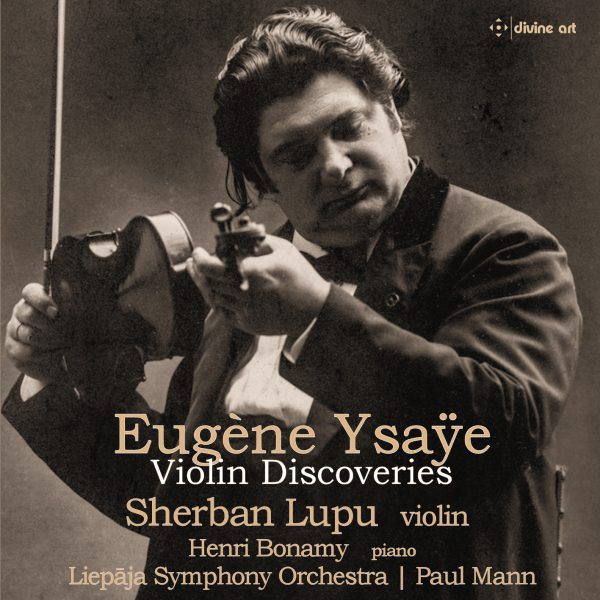Fanfare
Eugene Ysaÿe: Violin Discoveries (Divine Art) is a heartfelt and affectionate tribute not just to the legendary Belgian violinist and composer, but to one of his most distinguished pupils. Violinist Sherban Lupu studied with Joseph Gingold in the 1970s at Indiana University. Gingold, a beloved teacher and himself a distinguished violinist, studied with Ysaÿe in Belgium from 1927-30. Gingold told Lupu that “Ysaÿe often improvised and that his improvisations were far more interesting than the six sonatas he wrote. However, at the same time he was writing music continuously. Therefore, I felt it was my duty, my task, and my calling to try to find out what else Ysaÿe wrote. It is a tribute to my teacher.” In pursuit of this “calling,” Lupu visited the Royal Library of Belgium in Brussels, and the Royal Conservatory of Liege. In the latter institution, Lupu found a stack of Ysaÿe manuscripts, “Twelve feet long and three feet [in height].” Lupu searched through those documents, which provided the source material for the pieces heard on this release. All receive their world premiere recordings here, with the exception of the Petite fantaisie romantique (c. 1901). The manuscript of this work that resides at the Liege Conservatory includes a dedication from Ysaÿe’s son Antoine to Gingold: “You are a wonderful pupil of Ysaÿe and a witness to his legacy, so you should enjoy this piece.” Lupu edited the various pieces from the source manuscripts, “adding fingerings and bowings.” Some additional work was required. For Ysaÿe’s Elégie (c. 1912), Lupu fashioned the title, and completed the work’s ending. The manuscript for the first of the three Etudes-Poèmes (1924), “Serenade,” included only a violin part. However, the existence of two bars of rest at the work’s outset suggested that Ysaÿe contemplated a piano as well. Composer Sabin Pautza creno accompaniment for this recording. Pautza also orchestrated the Ysaÿe Violin Concerto in G Minor (1910). At least four separate manuscripts of this work exist, and they document a compositional process that spanned 1893-1910. The manuscripts contain various references to instrumentation of the music assigned to the piano. Pautza used this information to craft his orchestration.
I am grateful to Sherban Lupu for all of his devoted and tireless work to make these Ysaÿe compositions available to the public. It appears that Ysaÿe intended this music for his own performance (Ysaÿe, at various times, did contemplate dedicating the Violin Concerto to a pupil at the Brussels Royal Conservatoire, and to George Enescu). Both contemporary accounts of Ysaÿe’s playing, and precious recordings he made in the early part of the 20th century, document the artistry of a consummate musician. Ysaÿe played with a gorgeous tonal quality, impeccable intonation, a complete mastery of technical hurdles, and a beguiling gift of phrasing. All of the featured works afford the violinist abundant opportunities to display these qualities. The various pieces are beautifully crafted, with beguiling melodies and harmonies cast in an accessible late-Romantic idiom. The works for violin and piano are self-contained concert works, designed to be part of a recital program. The Violin Concerto is cast in a single movement in sonata form. The orchestration, as conceived by Sabin Pautza, is quite colorful, suggesting at times Komgold’s sound world. It would be a tall order indeed
to expect a violinist to evoke in these works the spirit of Ysaÿe’s mastery. That said, Sherban Lupu’s committed and musical performances are more than sufficient to allow enjoyment and appreciation of these welcome Ysaÿe discoveries. Lupu is ably partnered by pianist Henri Bonamy and, in the concerto, by the Liepaja Symphony Orchestra and conductor Paul Mann. The recorded sound is fine, although I would have preferred a bit less resonance surrounding the violin. Qianyi Fan’s liner notes offer a great deal of pertinent information, and convey the devotion Sherban Lupu lavished upon this project. This is a most valuable and welcome release.
@divineartrecordingsgroup
A First Inversion Company
Registered Office:
176-178 Pontefract Road, Cudworth, Barnsley S72 8BE
+44 1226 596703
Fort Worth, TX 76110
+1.682.233.4978












